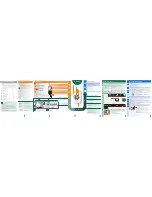
INSTALLATION
Warning:
Installation must be carried out by qualified personnel and according to the manufacturer's instructions. Incorrect
installation may cause damage or injury to persons.
The machine can be installed anywhere, providing that the ambient temperature is not les than 3
°
C and that the
cables and pipes at the rear of the machine are not crushed.
Unpacking:
Transport the machine to near its installation place and remove the external packing (Fig.1). If the integrity of the
machine is in doubt, do not use it. Seek advice from qualified personnel.
During transport, the machin's rocker group is locked in place by 4 plastic spacers with screws. Before starting
up the machine, loosen the screws with a suitable key and remove the screws and the plastic spacers
(Fig. 2). Put the screws and spacers aside for use in case of future transport.
N.B.
If the plastic spacers fall into the machine, open the side panel by loosening the three screews indicated with
V in figure 2, remove the spacers and replace the panel.
* Lift the machine and remove the base (Fig.3A).
* Tilt the machine and extract the two inner polystyrene corner elements( if foreseen) by pulling the two cardboard
tabs E-F. Extract tab E first, then tab F (Fig.3B).
Setting in place:
Move the machine with care until it is close to the connection points.
WHEN REQUIRED, to facilitate movement use the transporter wheel. To activate this, move the lever on the bottom
left hand side to the opposite side. Once the machine has been moved, return the lever to its original position (Fig.
4).
To enable the machine to operate correctly it must be set on a level.
This can be done by adjusting the screw feet (Fig. 5) on the base of the unit (2 feet for machines with rear wheels,
4 feet for machines with no wheels).
Once the machine has been set level, lock the screw feet by tightening the nut on the base of the machine using a
spanner.
Electrical connection:
Check that the voltage written on the technical data plate on the inside of the door filter corresponds to the mains
supply voltage. The counter, pressure relief valve, supply lines and power connection have all been designed for
the maximum load requested (Fig.6).
insert the plug in the socket, ensuring that it is fitted with an earth (Fig.7).
If the electrical socket in which the plug of the machine is inserted is unsuitable, have the socket replaced by qualified
personnel. It is good practice to avoid the use of adapters, extension leads and multiple sockets.
Water connection:
Turn on the tap and allow a good quantity of water to flow until it is clear and free from impurities. This procedure
is especially applicable in the case of new water systems or those that have remained unused for some time. Connect
the water supply hose to the tap, inserting the filter provided, and hand tighten (Fig.8).
Check that the other end of the hose is tight on the inlet (Fig.9).
Position the discharge hose at a minimum height of 60 cm, though not more than 90 cm, from the ground (Fig.10).
N.B. To prevent siphoning, do not hermetically seal the machine's discharge hose.
If the water system does not have a discharge system, use the special "U" fitting to hook the hose over the edge
of a washbasin and tie it to the tap (Fig.11). Remember that the hoses must not be squashed when manoeuvring
the machine against the wall.
3






























